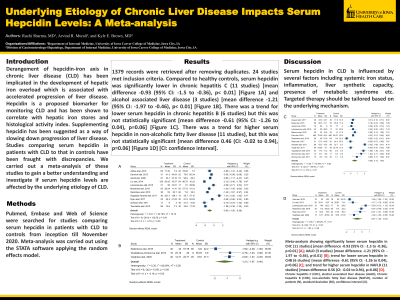Back


Poster Session B - Monday Morning
Category: Liver
B0515 - Underlying Etiology of Chronic Liver Disease Impacts Serum Hepcidin Levels: A Meta-Analysis
Monday, October 24, 2022
10:00 AM – 12:00 PM ET
Location: Crown Ballroom

Has Audio

Ruchi Sharma, MD
University of Iowa Hospital and Carver College of Medicine
Coralville, IA
Presenting Author(s)
Ruchi Sharma, MBBS, MS, MRCS1, Arvind R. Murali, MD2, Kyle E. Brown, MD3
1University of Iowa Hospital and Carver College of Medicine, Coralville, IA; 2Orlando Health, Orlando, FL; 3University of Iowa Hospitals and Clinics, Iowa City, IA
Introduction: Derangement of hepcidin-iron axis in chronic liver disease (CLD) has been implicated in the development of hepatic iron overload which is associated with accelerated progression of liver disease. Hepcidin is a proposed biomarker for monitoring CLD and has been shown to correlate with hepatic iron stores and histological activity index. Supplementing hepcidin has been suggested as a way of slowing down progression of liver disease. Studies comparing serum hepcidin in patients with CLD to that in controls have been fraught with discrepancies. We carried out a meta-analysis of these studies to gain a better understanding and investigate if serum hepcidin levels are affected by the underlying etiology of CLD.
Methods: Pubmed, Embase and Web of Science were searched for studies comparing serum hepcidin in patients with CLD to controls from inception till November 2020. Meta-analysis was carried out using the STATA software applying the random effects model.
Results: 1379 records were retrieved after removing duplicates. 24 studies met inclusion criteria. Compared to healthy controls, serum hepcidin was significantly lower in chronic hepatitis C (11 studies) [mean difference -0.93 (95% CI: -1.5 to -0.36), p< 0.01] [Figure 1A] and alcohol associated liver disease (3 studies) [mean difference -1.21 (95% CI: -1.97 to -0.46), p< 0.01] [Figure 1B]. There was a trend for lower serum hepcidin in chronic hepatitis B (6 studies) but this was not statistically significant [mean difference -0.61 (95% CI: -1.26 to 0.04), p=0.06] [Figure 1C]. There was a trend for higher serum hepcidin in non-alcoholic fatty liver disease (11 studies), but this was not statistically significant [mean difference 0.46 (CI: -0.02 to 0.94), p=0.06] [Figure 1D] [CI: confidence interval].
Discussion: Serum hepcidin in CLD is influenced by several factors including systemic iron status, inflammation, liver synthetic capacity, presence of metabolic syndrome etc. Targeted therapy should be tailored based on the underlying mechanism.

Disclosures:
Ruchi Sharma, MBBS, MS, MRCS1, Arvind R. Murali, MD2, Kyle E. Brown, MD3. B0515 - Underlying Etiology of Chronic Liver Disease Impacts Serum Hepcidin Levels: A Meta-Analysis, ACG 2022 Annual Scientific Meeting Abstracts. Charlotte, NC: American College of Gastroenterology.
1University of Iowa Hospital and Carver College of Medicine, Coralville, IA; 2Orlando Health, Orlando, FL; 3University of Iowa Hospitals and Clinics, Iowa City, IA
Introduction: Derangement of hepcidin-iron axis in chronic liver disease (CLD) has been implicated in the development of hepatic iron overload which is associated with accelerated progression of liver disease. Hepcidin is a proposed biomarker for monitoring CLD and has been shown to correlate with hepatic iron stores and histological activity index. Supplementing hepcidin has been suggested as a way of slowing down progression of liver disease. Studies comparing serum hepcidin in patients with CLD to that in controls have been fraught with discrepancies. We carried out a meta-analysis of these studies to gain a better understanding and investigate if serum hepcidin levels are affected by the underlying etiology of CLD.
Methods: Pubmed, Embase and Web of Science were searched for studies comparing serum hepcidin in patients with CLD to controls from inception till November 2020. Meta-analysis was carried out using the STATA software applying the random effects model.
Results: 1379 records were retrieved after removing duplicates. 24 studies met inclusion criteria. Compared to healthy controls, serum hepcidin was significantly lower in chronic hepatitis C (11 studies) [mean difference -0.93 (95% CI: -1.5 to -0.36), p< 0.01] [Figure 1A] and alcohol associated liver disease (3 studies) [mean difference -1.21 (95% CI: -1.97 to -0.46), p< 0.01] [Figure 1B]. There was a trend for lower serum hepcidin in chronic hepatitis B (6 studies) but this was not statistically significant [mean difference -0.61 (95% CI: -1.26 to 0.04), p=0.06] [Figure 1C]. There was a trend for higher serum hepcidin in non-alcoholic fatty liver disease (11 studies), but this was not statistically significant [mean difference 0.46 (CI: -0.02 to 0.94), p=0.06] [Figure 1D] [CI: confidence interval].
Discussion: Serum hepcidin in CLD is influenced by several factors including systemic iron status, inflammation, liver synthetic capacity, presence of metabolic syndrome etc. Targeted therapy should be tailored based on the underlying mechanism.

Figure: Meta-analysis showing significantly lower serum hepcidin in CHC (11 studies) [mean difference -0.93 (95% CI: -1.5 to -0.36), p<0.01] [A]; AALD (3 studies) [mean difference -1.21 (95% CI: -1.97 to -0.46), p<0.01] [B]; trend for lower serum hepcidin in CHB (6 studies) [mean difference -0.61 (95% CI: -1.26 to 0.04), p=0.06] [C]; and trend for higher serum hepcidin in NAFLD (11 studies) [mean difference 0.46 (CI: -0.02 to 0.94), p=0.06] [D].Chronic hepatitis C (CHC), alcohol associated liver disease (AALD), Chronic hepatitis B (CHB), non-alcoholic fatty liver disease (NAFLD), number of patients (N), standard deviation (SD), confidence interval (CI).
Disclosures:
Ruchi Sharma indicated no relevant financial relationships.
Arvind Murali indicated no relevant financial relationships.
Kyle Brown indicated no relevant financial relationships.
Ruchi Sharma, MBBS, MS, MRCS1, Arvind R. Murali, MD2, Kyle E. Brown, MD3. B0515 - Underlying Etiology of Chronic Liver Disease Impacts Serum Hepcidin Levels: A Meta-Analysis, ACG 2022 Annual Scientific Meeting Abstracts. Charlotte, NC: American College of Gastroenterology.
